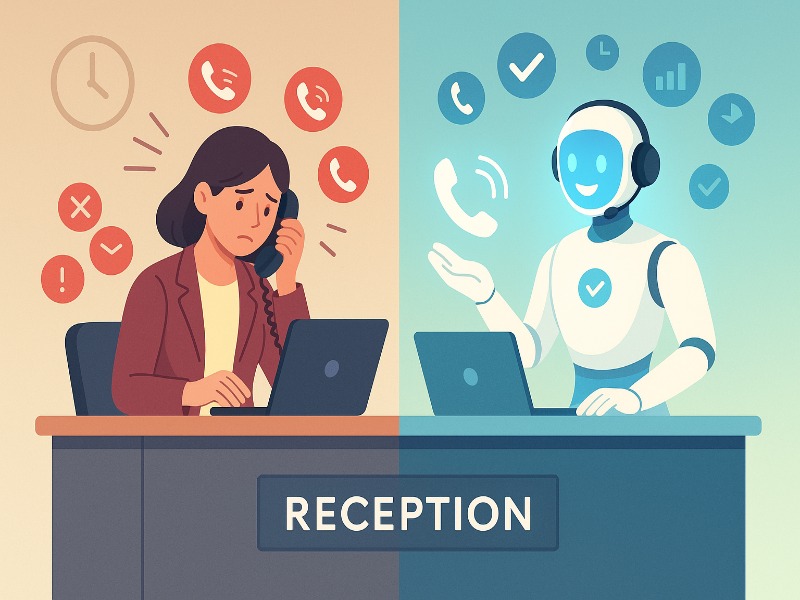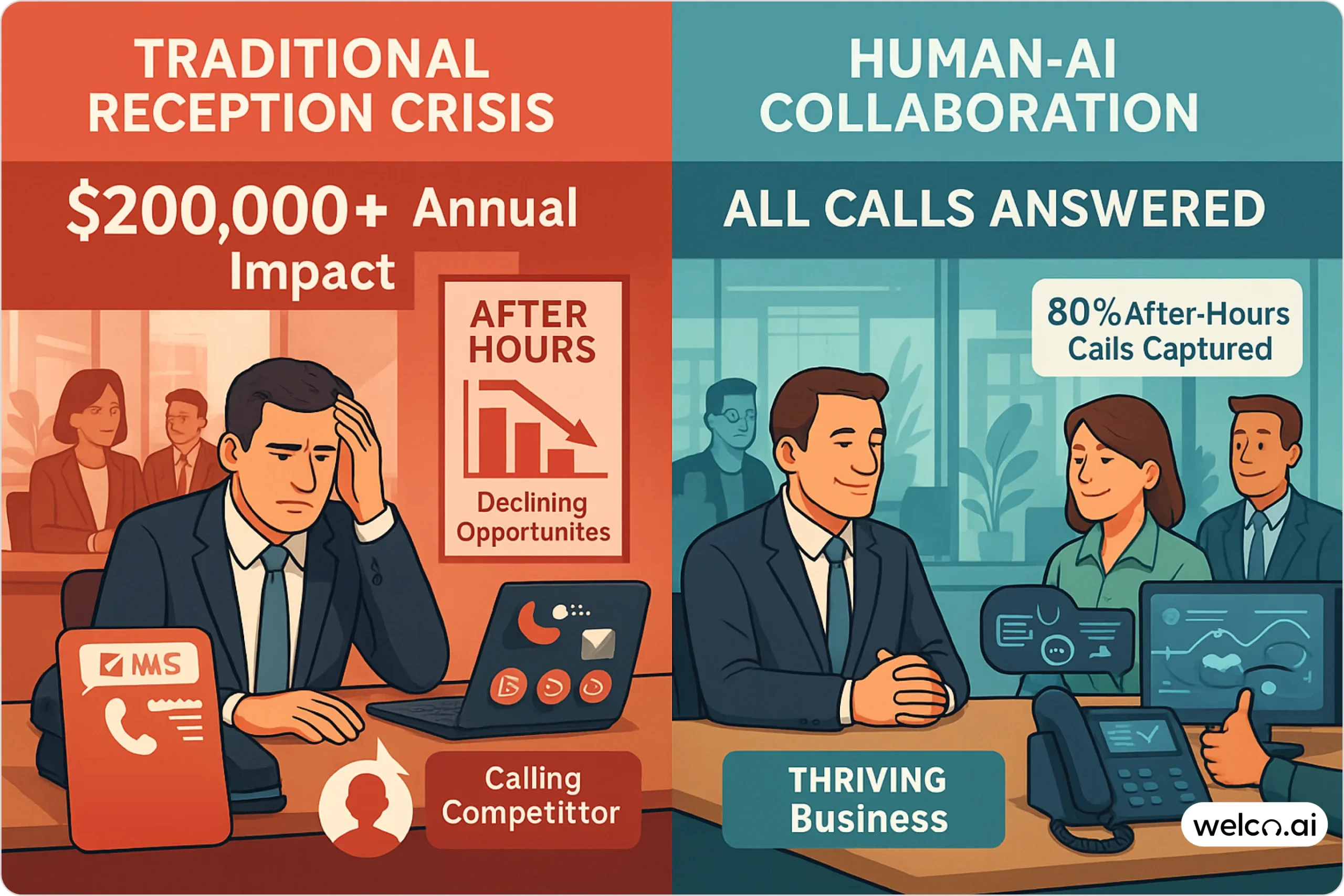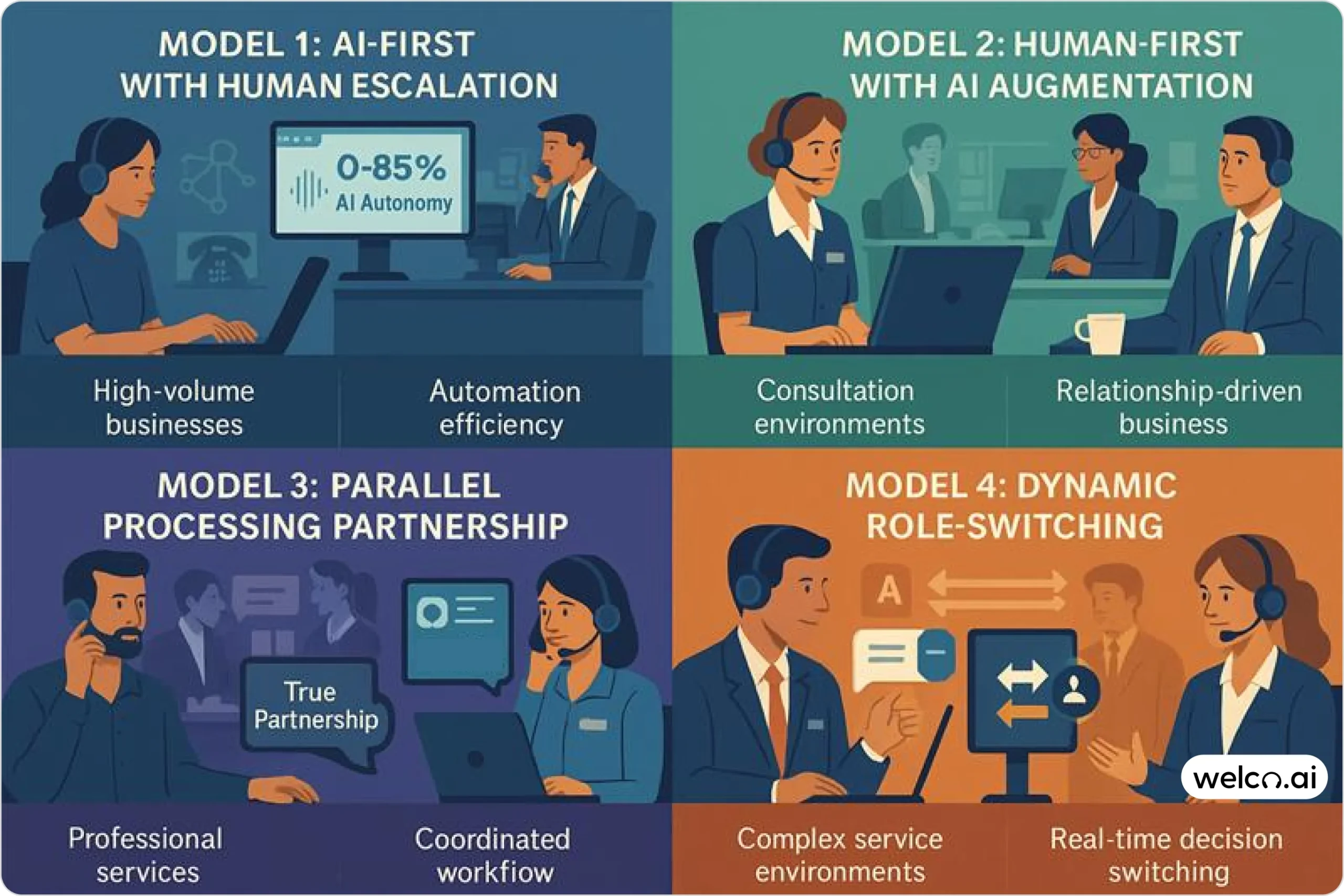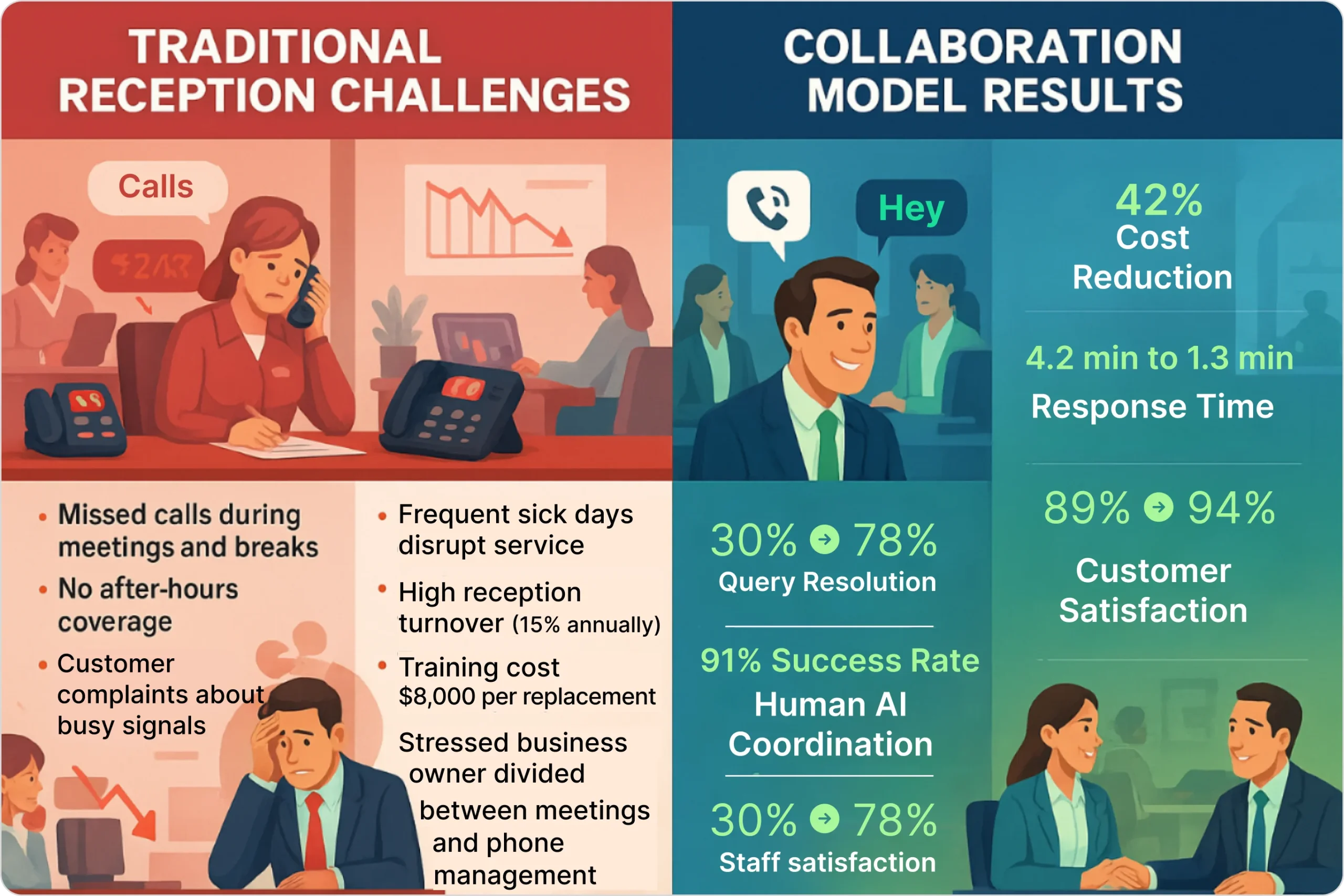- Quick Assessment: Is This Affecting Your Business?
- The Hidden Economics of Traditional Reception
- Understanding Human-AI Collaboration Models
- The Four Core Human-AI Collaboration Models
- How Models Make Smart Decisions
- Choosing the Right Collaboration Model for Your Business
- Collaboration Model Implementation Process
- Virtual Receptionist Pricing by Collaboration Model
- Measuring Collaboration Model Success
- Security and Compliance in Collaborative Models
- The Future of Human-AI Collaboration Models
- Frequently Asked Questions
The Real Cost of Missed Calls: How Human-AI Collaboration Models Transform Business Reception

Quick Assessment: Is This Affecting Your Business?
We miss calls during lunch/breaks
No coverage after 5 PM
Staff calls in sick frequently
Customers complain about busy signals
If you checked 2+, you’re likely missing revenue opportunities.
Every business owner faces this dilemma: You’re in an important meeting when your phone rings. Do you take the call and disrupt your current client, or let it go to voicemail and risk losing a new opportunity?
Based on our analysis of small to medium businesses, we’ve observed that roughly 80% of calls outside office hours go unanswered. While the exact revenue impact varies by industry, many service businesses report losing substantial opportunities from missed connections. This challenge has driven the evolution toward modern reception solutions that balance technology with human expertise.

The Hidden Economics of Traditional Reception
When calculating reception costs, most businesses only consider salary. Here’s what we typically see with traditional phone answering systems:
Direct Costs:
- Full-time receptionist: $45,000/year salary + $15,000 benefits
- High turnover (reception roles average 75% annually)
- Training and replacement: approximately $8,000 per turnover
Indirect Costs:
- Missed calls during breaks, sick days, and after hours
- Inconsistent service quality affecting brand perception
- Lost opportunities that are difficult to quantify
Total annual impact for most small to medium businesses often exceeds $200,000.
But replacing human reception entirely with automated phone systems isn’t ideal either. Customer research consistently shows that people prefer human interaction for complex issues. Pure automation can feel impersonal and create frustration when customers need genuine help.
Understanding Human-AI Collaboration Models
Instead of choosing between humans and AI, successful businesses are implementing proven collaboration frameworks that leverage both intelligences strategically. Research in human-AI partnership identifies four primary collaboration models, each suited to different business scenarios.
The Four Core Human-AI Collaboration Models
Model 1: AI-First with Human Escalation
“AI does most of the work”
Framework: AI handles the majority of interactions, escalating complex issues to humans based on predefined triggers.
How it works: AI phone agents manage 70-85% of calls independently, using natural language processing to identify when human intervention is needed. Escalation occurs automatically based on emotional indicators, complexity thresholds, or customer value. This approach leverages emerging voice AI technology trends to create seamless customer experiences.
Best for: High-volume businesses with standardized processes (e-commerce, basic service inquiries)
Collaboration dynamics: AI acts as the primary interface while humans serve as specialized problem-solvers for edge cases.
Model 2: Human-First with AI Augmentation
“Humans do most of the work, AI helps”
Framework: Humans remain the primary contact point, but AI provides real-time support, information, and decision assistance.
How it works: AI virtual assistants support human agents with instant access to customer history, suggested responses, and procedural guidance during calls. The AI operates as an intelligent co-pilot rather than taking direct customer interaction. This model represents the future workplace virtual assistance approach that many organizations are adopting.
Best for: High-touch service businesses, complex consultations, relationship-driven industries
Collaboration dynamics: Humans lead the interaction while AI enhances their capabilities through real-time intelligence.
Model 3: Parallel Processing Partnership
“AI and humans work on the same call together”
Framework: Both AI and humans work simultaneously on different aspects of the same customer interaction.
How it works: While the AI receptionist engages with the customer, AI systems simultaneously analyze tone, pull relevant data, schedule follow-ups, and prepare human specialists with context. The customer experiences seamless service while multiple intelligences coordinate behind the scenes.
Best for: Professional services, healthcare, legal practices requiring both efficiency and expertise
Collaboration dynamics: True partnership where both intelligences contribute unique value to each interaction.
Model 4: Dynamic Role-Switching Collaboration
“AI and humans switch who’s in charge mid-call”
Framework: AI and humans fluidly exchange primary responsibility based on real-time assessment of customer needs and conversation flow.
How it works: The system continuously evaluates conversation complexity, emotional state, and resolution requirements. Control seamlessly shifts between AI phone agents and humans multiple times within a single call as needed. This sophisticated approach enables voice search and business discovery capabilities while maintaining human oversight for quality assurance.
Best for: Complex service environments with unpredictable interaction patterns
Collaboration dynamics: Adaptive partnership that optimizes for real-time customer needs rather than predetermined roles.
💡 Pro Tip from Implementation Experience: Most businesses think they need Model 4 (Dynamic Role-Switching) because it sounds most advanced, but we’ve found that 80% of companies actually get better results starting with Model 3 (Parallel Processing). The complexity of dynamic switching often creates more confusion than value in the first 6 months.
⚠️ Common Mistake: Don’t choose a collaboration model based on what sounds most impressive. We’ve seen companies struggle for months with Model 4 when Model 1 would have solved their problems immediately. Match the model to your actual call patterns, not your aspirations.

Real-World Model Implementation: Professional Services Firm
A 45-employee consulting firm implemented Model 3: Parallel Processing Partnership after missing 60% of after-hours calls. Their hybrid AI phone system was deployed over six weeks with these results after three months:
- Query resolution rate: 30% → 78%
- Average response time: 4.2 minutes → 1.3 minutes
- Operational costs: 42% reduction
- Customer satisfaction: 89% → 94%
- Human-AI coordination efficiency: 91% (measured by successful handoffs and context retention)
“Our clients have noticed the difference immediately. Sarah from our team said she actually enjoys answering phones now because the AI handles all the routine stuff. We’re not just faster – we’re actually better at helping people.” – Operations Director
This implementation demonstrates how thoughtful Human-AI collaboration models can transform business operations while maintaining the personal touch customers value.
How Models Make Smart Decisions
Each human-AI collaboration model relies on a decision-making framework that determines who handles what in real-time:
Smart Task Assignment
The system checks who’s busy and who’s available (human or AI) and assigns tasks accordingly. This prevents human overwhelm while maximizing AI utilization.
Strength Mapping
AI-assisted decision making evaluates each interaction against what each intelligence does best:
- AI Strengths: Pattern recognition, data retrieval, consistent processes, 24/7 availability
- Human Strengths: Emotional intelligence, creative problem-solving, complex judgment, relationship building
- Collaborative Strengths: Context synthesis, quality assurance, continuous learning
Expertise-Based Routing
The framework routes interactions based on what’s needed, not just who’s available:
- Routine Tasks: FAQ responses, scheduling, basic information → AI-optimized
- Complex Issues: Technical troubleshooting, negotiations → Human-led with AI support
- Relationship Management: VIP customers, sensitive situations → Human-primary with AI context
Choosing the Right Collaboration Model for Your Business
Simple Decision Matrix:
- Simple Tasks + High Volume = Model 1 (AI-First)
- Complex Tasks + Low Volume = Model 2 (Human-First)
- Complex Tasks + High Volume = Model 3 (Parallel Processing)
- Unpredictable Mix = Model 4 (Dynamic Switching)
Industry-Specific Model Applications:
Healthcare Practices
Model 2 (Human-First): AI receptionists support human staff with patient data, scheduling optimization, and regulatory compliance while maintaining the personal touch patients expect. This approach addresses critical AI ethics in customer communication considerations essential in healthcare settings.
Legal Firms
Model 3 (Parallel Processing): AI phone services handle conflict screening and initial intake while simultaneously preparing attorneys with case context and client history. These systems often incorporate predictive service capabilities to anticipate client needs and streamline legal consultations.
Financial Services
Model 1 (AI-First): AI virtual receptionists manage routine inquiries and identity verification, escalating to human advisors for investment decisions and complex financial planning.
Small Businesses
Model 4 (Dynamic Role-Switching): AI answering services adapt fluidly between fully autonomous operation during busy periods and collaborative support when owners are available. This flexibility supports omnichannel integration strategies that small businesses need to compete effectively.
Collaboration Model Implementation Process
Step 1: Model Selection & Design (Week 1-2)
- Assess current call patterns and complexity distribution
- Map human expertise and AI capability requirements
- Select optimal collaboration framework based on business needs
- Design human-AI handoff protocols and escalation triggers
Step 2: Collaborative Training (Week 3-4)
- Train AI systems on business-specific knowledge and processes
- Educate human team on AI partnership protocols and optimal collaboration patterns
- Establish collaborative intelligence metrics and success indicators
- Create feedback loops for continuous model refinement
Step 3: Model Deployment & Optimization (Week 5-8)
- Deploy chosen human-AI collaboration model with careful monitoring
- Track collaboration effectiveness metrics alongside traditional KPIs
- Fine-tune decision-making algorithms based on real-world performance
- Optimize human-AI workflow patterns for maximum synergy
Reality check: Different collaboration models have varying learning curves. Model 1 (AI-First) typically shows immediate improvements, while Model 4 (Dynamic Role-Switching) requires 60-90 days for optimal collaborative intelligence to develop.
Virtual Receptionist Pricing by Collaboration Model
Model 1 (AI-First): $400-600/month – Lowest cost due to high AI autonomy
Model 2 (Human-First): $800-1,200/month – Higher cost for AI augmentation tools
Model 3 (Parallel Processing): $1,000-1,500/month – Premium for sophisticated coordination
Model 4 (Dynamic Role-Switching): $1,200-2,000/month – Highest cost for adaptive intelligence
Key considerations:
- Collaboration complexity affects pricing more than call volume
- Look for providers offering model flexibility as your business evolves
- Factor in human training costs for collaborative workflows
- Ensure pricing includes collaborative intelligence analytics and optimization
Measuring Collaboration Model Success
Traditional Metrics:
- Call resolution rates and response times
- Customer satisfaction scores
- Cost per interaction and overall ROI
Collaboration-Specific Metrics:
- Human-AI handoff success rate (seamless transitions without customer frustration)
- Stress reduction (human stress reduction, AI utilization efficiency)
- Learning speed (how quickly the model improves through human-AI feedback)
- Synergy effectiveness (outcomes achievable only through collaboration vs. either intelligence alone)
Security and Compliance in Collaborative Models
Human-AI collaboration introduces unique security considerations:
Data Protection:
- Encrypted human-AI communication channels
- Role-based access controls for collaborative workflows
- Audit trails for collaborative decision-making processes
Compliance Framework:
- Human oversight requirements for regulated industries
- AI transparency in collaborative decisions
- Collaborative accountability for customer outcomes

The Future of Human-AI Collaboration Models
The key is finding the right collaboration framework for your specific business needs. Start by honestly assessing your current phone answering costs and service gaps, then evaluate which human-AI partnership model addresses your particular challenges.
Next steps:
- Calculate your true reception costs (including missed calls)
- Assess your collaboration readiness using the Simple Decision Matrix
- Identify which human-AI collaboration model aligns with your business patterns
- Research AI phone service providers that support multiple collaboration frameworks
- Start with a pilot program testing your chosen collaboration model before full commitment
The goal isn’t to replace human connection but to create collaborative intelligence that ensures every customer gets optimal service through the perfect blend of human empathy and AI efficiency. As these technologies continue evolving, we can expect to see even more sophisticated emerging voice AI technology trends that will further enhance human-AI partnership capabilities.
Frequently Asked Questions
How do I know which human-AI collaboration model is right for my business?
Use the Simple Decision Matrix as a starting point. High-volume, routine interactions suit Model 1 (AI-First), while complex, relationship-driven businesses benefit from Model 2 (Human-First). Most growing businesses find Model 3 (Parallel Processing) offers the best balance of efficiency and quality.
Can I switch between collaboration models as my business grows?
Yes, the best AI phone systems support model evolution. Many businesses start with Model 1 and migrate to Model 3 as they scale. Look for providers offering collaborative framework flexibility rather than locked-in approaches.
How long does it take to train staff on human-AI collaboration?
Collaborative workflow training typically takes 1-2 weeks for basic proficiency, with full collaborative intelligence developing over 30-60 days. The key is focusing on partnership protocols rather than just individual AI or human skills.
What happens if the collaboration model doesn’t work as expected?
Modern human-AI collaboration systems include built-in model switching capabilities. If your chosen approach isn’t optimal, you can typically adjust collaboration parameters or migrate to a different model without starting over completely.
How do I measure the success of human-AI partnership beyond traditional metrics?
Focus on collaborative intelligence indicators: handoff success rates, stress reduction for staff, synergy effectiveness (outcomes impossible without collaboration), and learning speed. These metrics reveal the true value of human-AI collaboration models.
